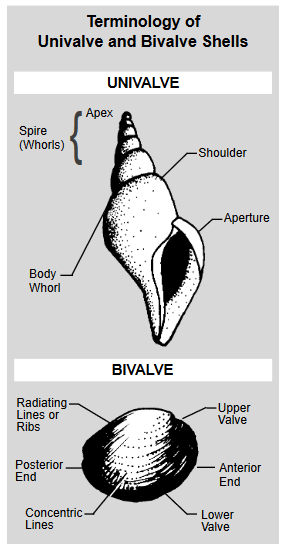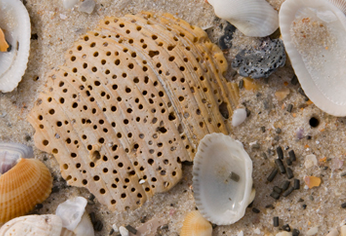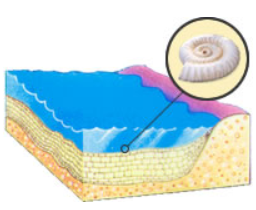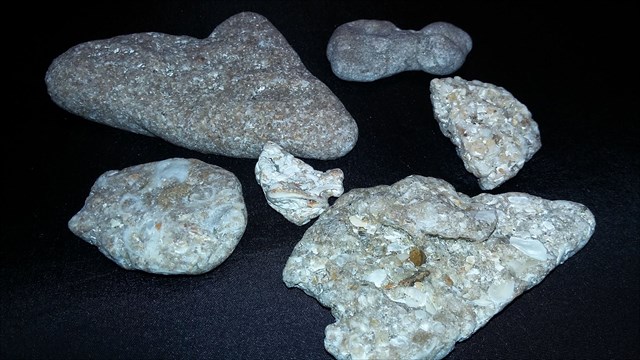Team Mollymap Proud Members Of The SCGA

NOTE: This is an earthcache, there is no physical container to find at the coordinates. To get your smiley for the cache, e-mail your answers for the questions below to the cache owner. This earthcache is located on a public beach there is a parking lot with parking meters near the cache.
On beautiful Cocoa Beach visitors are able to see seashells in three different states: whole shells, shells crushed into sand, and shells that have been formed into rock. This earthcache will tell a geologic story of the seashells.
Seashells:
Seashells belong to a marine class of animals called mollusks. Unlike people, marine mollusk seashells have their skeleton on the outside on their bodies, which called an exoskeleton. Seashells have three distinct layers and are composed mostly of a hard mineral called calcium carbonate. On the inside of the hard shell lives the animal which made of mantle tissue. It is rare to see a shell with the tissue still attached to the shell on the beach. Most often the shells are empty because the animal has died and the tissue has been eaten by another animal or rotted out.

Bivalves and Univalves
Mollusks are divided into many different types, but the two major ones are bivalves and univalves.
Bivalves are the most common types of seashells. Examples of bivalves would be clams and oysters. Most bivalves have two identical shells that are held together by a flexible hinge. Often times on the beach there are bivalve shells with only one half, this is due to the animal inside dying and the shell breaking apart by the wave action.
Univalves have one piece of shell which usually is in a snail shape. Examples of univalves would be conch, whelk, and nautilus seashells. Univalves belong to the gastropod family and have shells big enough so the soft parts of the animal can withdraw completely into it. Often times after a univalve dies the shell is taken and used by other sea creatures such as hermit crabs.

The best time to find shells on the beach is at low tide, after a storm, or during unusually strong tides.
Seashells to sand:
Most of the sand of The Cocoa Beach area contains: feldspar, mica, quartz, and shells. Quartz minerals are hexagonal shape and are extremely hard and durable. Mica is also durable, its flakes are very visible in beach sand, and give the beach its sparkle. Feldspar has a glassy luster and is broken in steep ridges. Its crystals tend to be blocky which helps distinguish them from quartz.
Quartz is the most common mineral on many beaches because of its durability and resistance to breaking down. Shells on the other hand are more delicate and break down easily by wave action or by organisms eating the shells. Organisms break down shells by: eating the animal inside the shell, using an empty shell for its home, or boring holes into shells. The age of the shell fragments on the beach can often be told by inspecting the edges of the shell fragments. Shell fragments with smooth and rounded edges indicate a long period of wear. The process of shells being broken down by wave action and organisms is a good thing though, because without them we would be up to our ears in shells!

Picture of shell that has been bored into by organism.
Seashells to rock:
At the icon coordinates you will see some jagged and interesting looking rocks. Upon closer inspection you will notice that the rocks are made of shells that have been cemented together. This rock is called coquina. Coquina Rock was formed during the Pleistocene Ice Age (1.8 million - 11,550) years ago. The end of the Pleistocene Era corresponds with the retreat of the last remaining continental glacier. During this last ice age the sea level dropped which exposed layers of shells to air and rain. Gradually the shells became covered with soil and then vegetation. Rain water seeped through the dead vegetation and soil which made carbonic acid. As the acid moved through the shell layer it dissolved the calcium in the shells and produced calcium carbonate. The calcium carbonate then glued the rest of the shell fragments together and the coquina rock was formed.

It is a geologic treat to be able to see coquina as it is mostly specific to Florida. During the retreat of the last continental glacier the land mass of Florida began rising from the sea. At this time coquina rock began forming along the East Coast of Florida. Formations can be found in the south from Palm Beach all the way up north to Jacksonville. The coquina rock is also found as far as 20 miles inland from the coastline. Coquina is officially defined as a course grained sedimentary rock composed of coral and broken shell debris that has been cemented in limestone. For sediment to be considered coquina the particles it is made up of should average 2mm or greater in size. Coquina is relatively soft when quarried, and hardens over the years, after surface exposure which can be seen at the icon coordinates.
 Coquina samples found washed up on Cocoa Beach
Coquina samples found washed up on Cocoa Beach
Now it is time for the questions. To get credit for the cache, please answer the questions below. When answering the questions do your best. It is more important that you learn a new concept about our earth and can apply your knowledge, rather than have a precise answer. To protect the sea turtles please stay away from the dunes and high tide line when answering questions.
Questions:
1- Near the icon coordinates you will find some large pieces of coquina rock and a memorial plaque. Looking at the coquina classify the ratio of shell particles to the rest of the rock. The shell particles are: 1) Abundant = 30 - 50% 2) Common = 10 - 30% 3) Sparse = 2 - 10% or 4) Trace = less than 2%
Walk down to the beach near the water to answer the next questions:
2- Find a whole sea shell and describe it in terms of color and size. Is the shell a univalve or bivalve?
3- Scoop up some sand in your hand and classify the ratio of shell particles to the other minerals in the sand. The shell particles are: 1) Abundant = 30 - 50% 2) Common = 10 - 30% 3) Sparse = 2 - 10% or 4) Trace = less than 2%
4- Did the scoop of sand or the coquina rock have a higher percentage of shell particles?
5- Why do you believe one has a higher percentage of shell particles than the other?
Thank you for visiting this earthcache. Please send your answers to the above questions to the cache owner. In your "found it" log feel free to write about your experience, but don't include the earthcache answers. Thanks and we hope you enjoy beautiful Cocoa Beach!

Sources:
http://www.scientificamerican.com/article/how-are-seashells-created/
https://en.wikipedia.org/wiki/Seashell
http://www.nbbd.com/godo/cns/Brochures/Shells.pdf
http://ntrs.nasa.gov/archive/nasa/casi.ntrs.nasa.gov/19910001129.pdf
http://www.calcium-carbonate.org.uk/calcium-carbonate/caco3-geology.asp
http://www.coquinarock.com/geology.php
http://beachchairscientist.com/2012/07/10/colorful-coquina-clams-sign-of-healthy-beach/
http://www.loving2learn.com/SuperSubjects/SuperScience/LifeScience/Water/SeaShellsChart.aspx
http://www.loyno.edu/lucec/natural-history-writings/where-do-shells-go-seaside-recycling
http://coastalcare.org/educate/beach-basics/